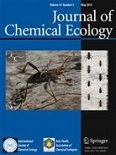When a tritrophic interaction goes wrong to the third level: xanthoxylin from trees causes the honeybee larval mortality in colonies affected by the river disease
Dublin Core
Título
Tema
Abstract
The “River Disease” (RD), a disorder impacting honeybee colonies located close to waterways with abundant riparian
vegetation (including Sebastiania schottiana, Euphorbiaceae), kills newly hatched larvae. Forager bees from RD-affected
colonies collect honeydew excretions from Epormenis cestri (Hemiptera: Flatidae), a planthopper feeding on trees of S.
schottiana. First-instar honeybee larvae fed with this honeydew died. Thus, we postulated that the nectars of RD-affected
colonies had a natural toxin coming from either E. cestri or S. schottiana. An untargeted metabolomics characterization of
fresh nectars extracts from colonies with and without RD allowed to pinpoint xanthoxylin as one of the chemicals present in higher amounts in nectar from RD-affected colonies than in nectars from healthy colonies. Besides, xanthoxylin was also
found in the aerial parts of S. schottiana and the honeydew excreted by E. cestri feeding on this tree. A larva feeding assay
where xanthoxylin-enriched diets were offered to 1st
instar larvae showed that larvae died in the same proportion as larvae did when offered enriched diets with nectars from RD-colonies. These findings demonstrate that a xenobiotic can mimic the RD syndrome in honeybee larvae and provide evidence of an interspecific flow of xanthoxylin among three trophic levels. Further, our results give information that can be considered when implementing measures to control this honeybee disease.
Autor
Fuente
Editor
Fecha
Derechos
Información sobre Derechos de Autor
(Por favor lea este aviso antes de abrir los documentos u objetos)
La legislación uruguaya protege el derecho de autor sobre toda creación literaria, científica o artística, tanto en lo que tiene que ver con sus derechos morales, como en lo referente a los derechos patrimoniales con sujeción a lo establecido por el derecho común y las siguientes leyes (LEY 9.739 DE 17 DE DICIEMBRE DE 1937 SOBRE PROPIEDAD LITERARIA Y ARTISTICA CON LAS MODIFICACIONES INTRODUCIDAS POR LA LEY DE DERECHO DE AUTOR Y DERECHOS CONEXOS No. 17.616 DE 10 DE ENERO DE 2003, LEY 17.805 DE 26 DE AGOSTO DE 2004, LEY 18.046 DE 24 DE OCTUBRE DE 2006)
ADVERTENCIA - La consulta de este documento queda condicionada a la aceptación de las siguientes condiciones de uso: Este documento es únicamente para usos privados enmarcados en actividades de investigación y docencia. No se autoriza su reproducción con fines de lucro. Esta reserva de derechos afecta tanto los datos del documento como a sus contenidos. En la utilización o cita de partes debe indicarse el nombre de la persona autora.
Formato
Idioma
Tipo
Identificador
Document Item Type Metadata
Original Format
- Fecha de agregación
- October 25, 2021
- Colección
- Bibliografía Nacional Química
- Tipo de Elemento
- Document
- Etiquetas
- Abejas, Epormenis Cestri, Metabolómica, Miel
- Citación
- Rossini, Carmen, “When a tritrophic interaction goes wrong to the third level:xanthoxylin from trees causes the honeybee larval mortality in colonies affected by the river disease,” RIQUIM - Repositorio Institucional de la Facultad de Química - UdelaR, accessed July 26, 2024, https://riquim.fq.edu.uy/items/show/6416.
- Archivos

